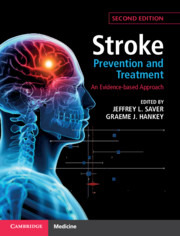Book contents
- Stroke Prevention and Treatment
- Stroke Prevention and Treatment
- Copyright page
- Dedication
- Contents
- Contributors
- Preface
- Part I Foundations
- Part II Systems of Care
- Part III Acute Treatment of Ischaemic Stroke and Transient Ischaemic Attack
- Chapter 5 Supportive Care during Acute Cerebral Ischaemia
- Chapter 6 Reperfusion of Ischaemic Brain by Intravenous Thrombolysis
- Chapter 7 Reperfusion of the Ischaemic Brain by Endovascular Thrombectomy and Thrombolysis
- Chapter 8 Collateral Flow Enhancement: Blood Pressure Lowering and Alteration of Blood Viscosity
- Chapter 9 Acute Antiplatelet Therapy for the Treatment of Ischaemic Stroke and Transient Ischaemic Attack
- Chapter 10 Acute Anticoagulant Therapy for the Treatment of Acute Ischaemic Stroke and Transient Ischaemic Attack
- Chapter 11 Treatment of Brain Oedema
- Chapter 12 Neuroprotection for Acute Brain Ischaemia
- Part IV Acute Treatment of Haemorrhagic Stroke
- Part V Prevention
- Part VI Stroke Rehabilitation and Recovery
- Index
- References
Chapter 12 - Neuroprotection for Acute Brain Ischaemia
from Part III - Acute Treatment of Ischaemic Stroke and Transient Ischaemic Attack
Published online by Cambridge University Press: 15 December 2020
- Stroke Prevention and Treatment
- Stroke Prevention and Treatment
- Copyright page
- Dedication
- Contents
- Contributors
- Preface
- Part I Foundations
- Part II Systems of Care
- Part III Acute Treatment of Ischaemic Stroke and Transient Ischaemic Attack
- Chapter 5 Supportive Care during Acute Cerebral Ischaemia
- Chapter 6 Reperfusion of Ischaemic Brain by Intravenous Thrombolysis
- Chapter 7 Reperfusion of the Ischaemic Brain by Endovascular Thrombectomy and Thrombolysis
- Chapter 8 Collateral Flow Enhancement: Blood Pressure Lowering and Alteration of Blood Viscosity
- Chapter 9 Acute Antiplatelet Therapy for the Treatment of Ischaemic Stroke and Transient Ischaemic Attack
- Chapter 10 Acute Anticoagulant Therapy for the Treatment of Acute Ischaemic Stroke and Transient Ischaemic Attack
- Chapter 11 Treatment of Brain Oedema
- Chapter 12 Neuroprotection for Acute Brain Ischaemia
- Part IV Acute Treatment of Haemorrhagic Stroke
- Part V Prevention
- Part VI Stroke Rehabilitation and Recovery
- Index
- References
Summary
More than 20,000 patients have participated in clinical trials of more than 100 neuroprotective therapies, but no study has provided convincing evidence of benefit. Several improvements to the rigor of preclinical agent qualification have been identified to increase the likelihood of success in human clinical trials: stringent randomization and blinding techniques to mitigate observer bias; assessment in in time periods achievable in the clinical setting; testing in older animals with comorbidities; and robust and reproducible benefit magnitudes. Human clinical trials should start agents hyperacutely, in the first minutes and hours after onset, when treatment effect would be maximal; target enrolment of patients likely to have transient rather than permanent ischaemic exposure; and use factorial and platform trial designs that would permit efficient testing of combinations of agents able to block multiple ischaemic injury-mediating pathways concurrently, including both anti-necrotic and anti-apoptotic interventions. For agents that allow cells to endure ischaemic stress, human trial delivery approaches include: prehospital initiation; initiation immediately upon brain imaging in patients destined for endovascular intervention; and initiation at outside hospitals in patients undergoing transfer to a neurothrombectomy center. For agents that mitigate reperfusion injury, treatment start before or concurrent with reperfusion, including intra-arterial administration via catheter immediately after endovascular thrombectomy, should be pursued.
Keywords
- Type
- Chapter
- Information
- Stroke Prevention and TreatmentAn Evidence-based Approach, pp. 214 - 238Publisher: Cambridge University PressPrint publication year: 2020

